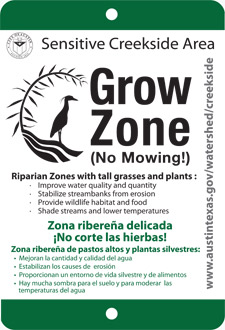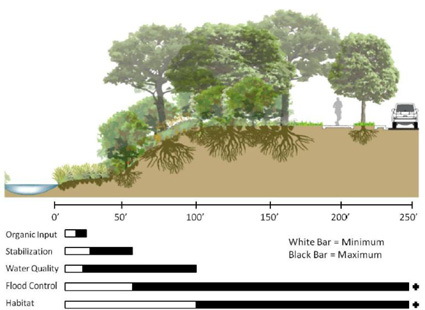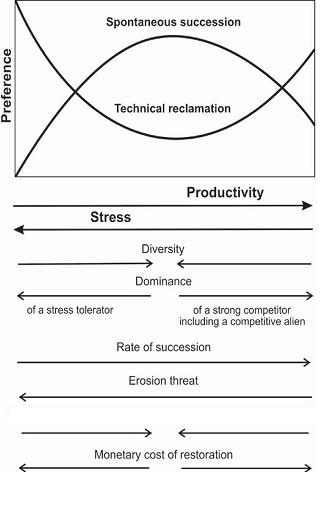 A “Grow Zone” is an effort to halt mowing along streams and allow the growth of more dense, diverse riparian vegetation. This improves water quality, lessens erosion, increases wildlife habitat, and provides other ecosystem services. It is our hope that Austinites will embrace these changes and appreciate the benefits of natural stream corridors. If you or your group is interested in getting involved please check out the options under the FAQ “What can I do?”
A “Grow Zone” is an effort to halt mowing along streams and allow the growth of more dense, diverse riparian vegetation. This improves water quality, lessens erosion, increases wildlife habitat, and provides other ecosystem services. It is our hope that Austinites will embrace these changes and appreciate the benefits of natural stream corridors. If you or your group is interested in getting involved please check out the options under the FAQ “What can I do?”
Ecosystem function can be defined as all of the processes necessary to preserve and create goods or services valued by humans. Healthy functioning riparian zones:
- Improves the natural and beneficial functions of the floodplain
- Prevents stream bank erosion
- Filters storm runoff, removing pollutants before they reach the creek
- Provides habitat and food for a diverse group of animals
- Provides shade that cools air and water temperatures
- Creates a greenbelt forest with diverse tree and plant communities for outdoor enthusiasts
- Reduces the City’s carbon footprint
Riparian zone restoration attempts to restore the natural process necessary to maintain a high level of ecosystem function. In general, the larger the riparian buffer the more ecosystem functions it can provide.

This image shows the various buffer widths associated with riparian zone function. Organic inputs into the stream are important sources of nutrients and habitat (width 15-25 ft). Stream stabilization is maintained by riparian vegetation (width 30-60 ft). Water quality is the ability of the vegetation to intercept runoff, retain sediments, remove pollutants, and promote groundwater recharge (width 20-100 ft). Flood control is the ability for the floodplain to intercept water and reduce peak flows (width 60- 500 ft). Riparian habitat is the ability of the buffer to support diverse vegetation and provide food and shelter for riparian and aquatic wildlife (width 100-1500 ft).
RIPARIAN ZONE RESTORATION METHODS
There are three generalized approaches to restoring a disturbed riparian environment:
(1) rely completely on passive (spontaneous succession)
(2) exclusively adopt active, technical measures
(3) or a combination of both passive and active techniques toward a target goal (Hobbs and Prach 2008). Passively restored sites exhibit robust biota better adapted to site conditions with increased natural value and wildlife habitat than do actively restored sites (Hobbs and Prach 2008).
Passive restoration requires minimal management and is more cost effective than alternative methods. However, passive restoration is often the slower approach and is more dependent on adjacent site conditions. When relying on spontaneous succession the vegetation community of adjacent sites, an approximate 100 meter distance from the disturbed site, is critical for successful restoration (Hobbs and Prach 2008). In general, passive restoration that relies on spontaneous succession should be employed when environmental disturbance is not very extreme (Figure 1) and no negative results (erosion, water contamination, negative aesthetic perception, etc…) are foreseen (Hobbs and Prach 2008). When site productivity and stress are extremely high or low, active (technical reclamation) may be necessary (Figure 1). The persistence of undesirable functional states is an indication that the system may be stuck and will require active intervention to move it to a more desirable state (Hobbs and Prach 2008). Understanding when passive versus active restoration approaches are warranted can increase chances of success and reduced project costs.
Passively restored sites exhibit robust biota better adapted to site conditions with increased natural value and wildlife habitat than do actively restored sites (Hobbs and Prach 2008). Passive restoration requires minimal management and is more cost effective than alternative methods. However, passive restoration is often the slower approach and is more dependent on adjacent site conditions. When relying on spontaneous succession the vegetation community of adjacent sites, an approximate 100 meter distance from the disturbed site, is critical for successful restoration (Hobbs and Prach 2008). In general, passive restoration that relies on spontaneous succession should be employed when environmental disturbance is not very extreme (Figure 1) and no negative results (erosion, water contamination, negative aesthetic perception, etc…) are foreseen (Hobbs and Prach 2008). When site productivity and stress are extremely high or low, active (technical reclamation) may be necessary (Figure 1). The persistence of undesirable functional states is an indication that the system may be stuck and will require active intervention to move it to a more desirable state (Hobbs and Prach 2008). Understanding when passive versus active restoration approaches are warranted can increase chances of success and reduced project costs.
